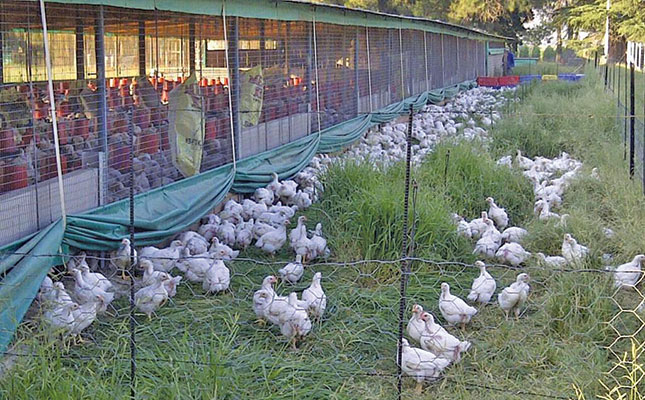Having grown up on a maize and cattle farm in Viljoenskroon in the Free State, Lynne Griesel understands the work ethic required to make a success of farming.
“It’s early mornings and late nights. Success comes with constant hard work, day in and day out. It’s not about working hard for just a season and then expecting to reap the rewards,” she says.
Griesel has been at the helm of Tulanie Chickens in Viljoenskroon for 15 years. What started out as a broiler chicken farm is today a thriving full-service operation that provides free-range chicken products and stretches across the value chain.

Griesel’s go-getter attitude has seen the business through the ups and downs of the economy and brought her the success she enjoys today.
“You have to be flexible to succeed. You can’t be set on an idea and stick with it regardless of the circumstances,” she says.
“When I was farming broiler chickens, I reached a point where I realised we couldn’t keep competing with larger businesses. The economy also took a dip at that stage and we faced shutting down.
“I decided to start farming free-range chickens, because our smaller business model would be in a better position to survive in a niche market. With free-range chickens, we could make more profit per chicken and that made all the difference.”
Abattoir
The switch was made in 2012, and the farm grew from strength to strength. Four years later, Griesel was able to buy an abattoir certified for free-range chickens. This gave her a competitive advantage over normal broiler abattoirs, as only 5% of abattoirs in South Africa have this certification.
Her business also has a value-adding section that prepares pre-packed chicken pieces and spiced, crumbed and marinated products.
Free-range chickens command a premium on the market, but also come at a higher production cost, notes Griesel. Farming free-range chickens is capital-intensive, with the greatest cost being feed, chicks, and infrastructure that allows for more space and movement of the birds.
While conventional chicken farming has a density of 23 chicks/m², Griesel keeps her rate at only 15 chicks/ m² to eliminate the strong competition for food and water.
“The chicks also have the option to move outside and experience natural sunlight, whereas conventional broilers are kept indoors and artificial light is used to stimulate growth,” she explains.
“Free-range chickens are not pushed to grow, but maintain a natural growth cycle. This means they are healthier and more appealing to health-conscious consumers.”
Limited interaction
Key to the health of the chickens is limited human interaction. Griesel explains that walking among chicks unsettles them and can cause them to trample each other.
“We’ve automated the water and feed systems so we need to go into the cages only twice a day to check that everything is working properly and remove any dead birds.”
Tulanie Chickens maintains a mortality rate of between 3% and 5%.
Griesel says that free-range chickens are slaughtered at around 42 days, compared with 33 days for conventional birds. This means that they are somewhat larger at around 2,2kg, compared with 1,7kg for their conventional counterparts.
She adds that consumers shopping for standard broilers prefer smaller birds, but Tulanie’s customers are satisfied with larger ones.
Griesel farms two chicken varieties, Cobb and Ross, and buys chicks from Grootvlei Kuikens in Kroonstad and National Chicks in Johannesburg.
She emphasises that there is nothing different about these birds; all chicks, whether destined for free-range or conventional production, are bred the same. The differences in terms of health and other parameters come later on and are due to what they are fed and how they are grown.
No hormones, antibiotics or growth stimulants are used in farming free-range chickens; neither is the meat injected with brine.
Griesel obtains her feed from Allen Brothers in Kroonstad, who have a special recipe for free-range feed. Its price can fluctuate quite a bit, and increases annually, mostly due to the imported oilcake used in the mix.
Market expansion
With the addition of the abattoir, Tulanie Chickens has had to contract four additional growers to keep the business at full capacity. These growers provide 50% of the 30 000 chickens slaughtered monthly.
Griesel says that the 10% premium they receive for the free-range chickens ensures the profitability of the operation.
“We have one cycle per year less than conventional farmers, because our birds are slaughtered later. But our health-conscious customers are willing to pay a bit extra. The fact that we have three income streams for the business (farming, slaughtering and value adding) means the economies of scale needed to succeed in broiler operations can be circumvented through this niche, full-service offering.”
Tulanie Chickens’ products are distributed across the Free State and Gauteng, to butcheries, restaurants and co-ops.
“Some 90% of our products are sold fresh, and although we do bulk orders, each is made up to suit the client’s specifications. This adds a lot of administration, but it’s worth it. It makes us different and secures our spot on the market,” says Griesel.
Tulanie Chickens also has a shop in Viljoenskroon. “The nearer you are to the customer, the more profitable your business.
“There’s the added benefit of being in touch with the needs of consumers and changing trends. This has prompted us to expand our value-added range.
“We’re also able to test new recipes on consumers and quickly make changes in production because it’s low volume. For example, we found that since fillets are expensive, and even more so as they’re free range, we don’t sell as many as other chicken pieces. So we started using fillet meat to make chicken burgers and nuggets, which are very popular.”
Nonetheless, she adds, price sensitivity still exists and they have to bear cost in mind when trying new products.
“If it’s tasty and convenient, our customers don’t mind paying extra. But there’s a level that consumers reach in terms of what they’ll pay for a product and one needs to understand that.”
The entire chicken
Tulanie Chickens utilises the entire chicken, with only a minimal amount going to waste.
Rejected or bruised meat is used for pet mince. Heads, feet and innards are sold at the depot to low-income markets.
Griesel admits that marketing is a time-consuming process.
The company’s trucks are branded, which brings awareness of Tulanie products wherever they travel, and social media and a comprehensive website assist with further marketing.
Griesel also approaches supermarkets directly, and regularly sends samples of her products to potential clients, following up with meetings.
She has seen an increasing demand for free-range chicken over the past few years, and the business is in the process of expanding its capacity to satisfy this.
“People have become far more health-conscious.
“There have been so many questions surrounding brine-injected and imported chickens that people are more concerned about what they eat.
“This is pushing up demand amongst middle- and upper-class consumers for our products.”
Operations and staff
As with most businesses, cash flow is one of the main obstacles faced by Tulanie Chickens.
“We sell in bulk. So if a client pays late, it has a big effect on cash flow and my ability to pay bills,” says Griesel.
She employees 80 people, most of them women.
“It’s important to look after one’s workers and ensure that each knows exactly what he or she needs to do.
“I believe in an open-door policy and encourage everyone to come up with ideas to streamline operations.
“One should be willing to learn from any employee, because these people perform their tasks every day. Who else is better placed to come up with an improved way of doing things?”
Griesel concludes that the best lessons come from experience.
“One needs to be involved in every aspect of the business to understand and manage it properly



